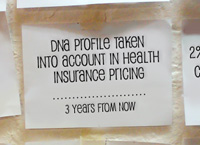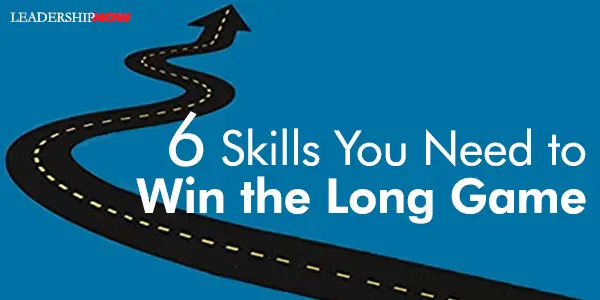 Leading Blog | Posts by Month |
 Leading Blog | Posts by Month |
02.28.15

LeadershipNow 140: February 2015 Compilation
See more on
Posted by Michael McKinney at 06:49 PM
02.27.15

How to Grow Your Ability to Detect Change EarlyLeaders anticipate. It’s what they do. It’s the vision thing.But how do you increase your personal visionary capacity? How do we look ahead and anticipate the future and turn it into a compelling story that ignites our followers? Rob-Jan de Jong assures us in Anticipate that “We all can work consciously and continuously to grow our ability to anticipate, improve our game of looking ahead, have more remarkable insights, and become more inspirational in how we speak about the future.” He divides the process into four parts: Visionary Content (generating the ingredients that go into a powerful vision), Visionary Practices (developing the ability to see change early and connect the dots), Visionary Self (mindsets and attitudes that allow you to become more visionary), and finally Visionary Communication (the ability to verbalize and communicate your vision powerfully). A good vision must be rational but it also has to connect emotionally. Two key components of a vision that gets results are unconventionality and a connection to a noble cause. So often, where we get stuck is having a strong sensitivity to the world around us so that we can respond in an appropriate manner. Part two was useful in this regard. Seeing into the future is a function of noticing – open-mindedness, listening, playfulness – and then being able to connect the dots or understanding the implications of the changing realities you see. The author introduces a method he calls FuturePriming. It is increasing your awareness and picking up on seemingly hidden, peripheral signals. The way it works is to begin to create FutureFacts which are manifestations of a possible changing reality.  The process involves engaging your imagination to a current trend and creating a possible “headline” three to five years out. For example, based on current science a possible FutureFact or headline might be “DNA Profile Taken into Account in Health Insurance Pricing.” this kind of headline is a concrete, telling headline you will remember, and will start to serve you as a prompt when you hear or read about something that’s mildly similar. The process involves engaging your imagination to a current trend and creating a possible “headline” three to five years out. For example, based on current science a possible FutureFact or headline might be “DNA Profile Taken into Account in Health Insurance Pricing.” this kind of headline is a concrete, telling headline you will remember, and will start to serve you as a prompt when you hear or read about something that’s mildly similar.
You engage your imagination by entertaining unconventional, possibly disruptive, future events.FuturePriming is a very interesting approach to developing your awareness and to help you to become more sensitive to the seemingly random events you see happening in the world around you. 
Posted by Michael McKinney at 04:18 PM
02.19.15

6 Skills You Need to Win the Long Game
BRIAN DODD says he doesn’t like meetings but he loves strategy sessions because they are about movement and focus on accomplishment, not activity. They “make you glad you are a leader.” I presume he would agree with authors Steven Krupp and Paul Schoemaker. They say the number one business challenge for winning the long game is for leaders to become more strategic. In Winning the Long Game they write that “In times of crisis and change, when people are confused about what to do, ordinary leadership must rise to the level of strategic leadership.” The trick is to deliver short-term results while securing long-term viability. Especially in uncertain times, “companies must tilt more toward strategic leadership than toward operational excellence.” Strategic leaders need two perspectives: outside in and future back. Outside in means that a “strategic leader starts with the external marketplace when addressing problems, without getting wrapped up by internal organizational issues.” Future back means that when playing the long game strategic leaders use their long-term vision to guide their short-term decisions in a flexible way.
Anticipate: Strategic leaders are constantly vigilant, honing their ability to anticipate by scanning the environment for signals of change. They develop and maintain an external mindset. How quickly do you spot ambiguous threats and opportunities on the periphery of your business? (Chapter 1: Elon Musk) “Once a company becomes the master of its own universe, seeing new developments in adjacent markets becomes harder. Challenge: Strategic leaders question the status quo. Pope Francis is listening to new voices and deliberately bypassing old channels of communication. Open a window to let in fresh air and look in the mirror. Are you comfortable with conflicting views and differences in opinion? How often do you question your own and other people’s assumptions? (Chapter 2: Sir Richard Branson, Pope Francis) “Opening the window is the practice of promulgating outside perspectives to see complex issues in context. Looking in the mirror is the practice of deep self-reflection, whereby leaders confront outmoded beliefs, faulty assumptions, and stubbornness in themselves and others.” Interpret: Strategic leaders amplify signals and connect multiple data points in new and insightful ways to make sense of complex, ambiguous situations. Can you pick up on signals to distinguish anomalies from leading indicators of change? What are you not seeing or hearing? We begin by recognizing the facts and then “re-cognizing,” or rethinking, them to expose their hidden implications. (Chapter 3: Charles O. Holliday Jr.) “Leaders get blindsided not so much because they aren’t receiving signals but because they aren’t exploring alternative interpretations, or they get locked into one piece of the puzzle.” Decide: Strategic leaders seek multiple options to ensure flexible decision-making. They don’t get prematurely locked into simplistic yes/no choices. How often and how quickly must you make tough calls with incomplete information? (Chapter 4: Angela Merkel, Laurence Golborne) “Exploring options means having the wisdom, cool-headedness, and perspective to consider all of the alternatives available. Showing courage means demonstrating the fortitude to commit to the right solution and, if that solution proves ineffective, critically stepping back to reconsider.” Align: Strategic leaders engage stakeholders to understand change readiness, manage differences and create buy-in. They are adept at finding common ground. This requires active outreach. Good communication is key. Do you regularly engage your managers’ direct reports in decisions that affect their work? Where do you stand with the people you need to influence? (Chapter 5: Alex Ferguson) “There is an interconnectedness now in problems—and this changes the issues. You need to have more people involved with the decision making, leaving the leader less in control of the situation.” Learn: Strategic leaders continuously reflect on successes and failures to improve performance and decision-making. I like this chapter title: My Gift Was Not Knowing. It sums it up well. A quarter of a century after the publication of Peter Senge’s The Fifth Discipline, “the learning organization still does not have much of a foothold in the business world, despite skyrocketing uncertainty.” When was the last time you admitted you were wrong—in public? (Chapter 6: Reed Hastings, Sara Blakely) “Leaders must make their moves when the future is still ambiguous. If an organization is continually learning, then everyone is primed for change and ready to move in a different direction each day.” 
Posted by Michael McKinney at 11:27 PM
02.03.15

4 Keys to Finding Hidden Leaders in Your OrganizationJim Kouzes writes in the foreword of The Hidden Leader that “Our images of who’s a leader and who’s not are all mixed up in our preconceived notions about what leadership is and isn’t.” Well put. That is the issue.He goes on to say that “hidden leaders are those people in your organization who share the belief that what they do matters.” And they are all around us. The authors Scott Edinger and Laurie Sain have developed some key indicators for finding the hidden leaders in your organization or team. These people can be “defined, identified, nurtured, and encouraged to help an organization develop a competitive edge.” Some will accept a position and others will prefer to stay off the organizational chart, but all can drive excellence throughout the organization. Hidden leaders display four key identifiers: they demonstrate integrity, lead through relationships, focus on results, and remain customer-focused no matter what role they have in the organization. Let’s look at them one by one: Demonstrate Integrity. Edinger and Sain believe that this is the “absolute bottom-line requirement of hidden leadership.” It means a consistent display in thoughts and actions of a strong ethical code of conduct that is “focused on the welfare of everyone.” Their consistent adherence to their beliefs makes them predictable and therefore dependable. They have the courage to do the right thing even when it is difficult. Lead Through Relationships. Leading through relationships is the basis of leadership. They get along with others and value others. They “lead and inspire because of who they are and how they interact with others.” They don’t depend on their position or lack of it to influence the actions of others. Focus on Results. The hidden leader “maintains a wide perspective and acts with independent initiative.” They use the end to define the means, which can mean working outside of strict processes to achieve the end result. “They aim for the end they are supposed to produce” so “they feel responsible and accountable, not just for the demands of their jobs but also for successful outcomes for stakeholders involved.” Remains Customer Purposed. This is different than customer service; it is an “awareness of how an action in a specific job affects the customer.” It is a big-picture focus and having a deep understanding of the value promise of an organization. For some hidden leaders one characteristic may dominate and others may need to be fully developed, but a hidden leader who lacks integrity, isn’t a hidden leader. Any leader needs support from other leaders in the organization and a good leader will make a priority out of developing others. Hidden leaders are easier to spot in flatter organizations and those that provide a greater number of areas to contribute. Listening to people at all levels is a big part of that. By recognizing hidden leaders we help to create a culture that develops more leaders. The hidden leaders are there. It is a leader’s responsibility to discover and develop them. The Hidden Leader contains worksheets and access to online resources to evaluate hidden leaders in your organization or team. Of Related Interest: 
Posted by Michael McKinney at 10:08 PM
02.01.15

First Look: Leadership Books for February 2015Here's a look at some of the best leadership books to be released in February.




For bulk orders call 1-800-423-8273  Build your leadership library with these specials on over 100 titles. All titles are at least 40% off the list price and are available only in limited quantities. “Wear the old coat and buy the new book.” — Austin Phelps
Posted by Michael McKinney at 08:16 AM
|
BUILD YOUR KNOWLEDGE


How to Do Your Start-Up Right STRAIGHT TALK FOR START-UPS 
Grow Your Leadership Skills NEW AND UPCOMING LEADERSHIP BOOKS 
Leadership Minute BITE-SIZE CONCEPTS YOU CAN CHEW ON 
Classic Leadership Books BOOKS TO READ BEFORE YOU LEAD |
|